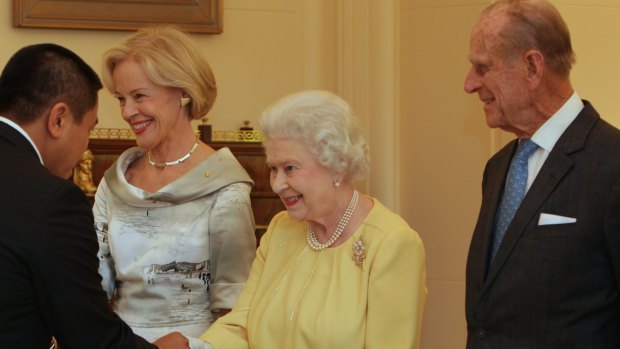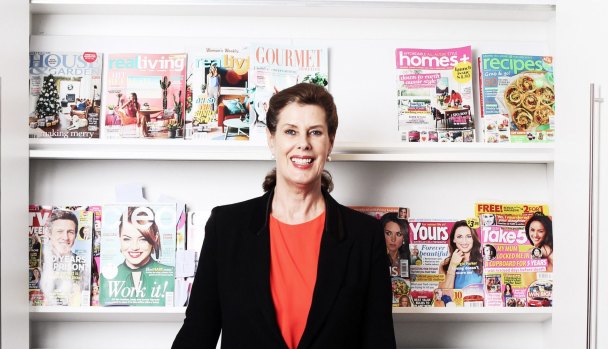From domesticity to diamonds: How a glossy mag brought the royals into our lounge rooms
In 1937, two little girls in white dresses with pearls and pink sashes peered from the cover of The Australian Women’s Weekly. “The King’s daughters,” the tagline read, promising more pictures taken by their father, George VI, inside.
A decade later the sisters were on the cover again, this time with Elizabeth’s dashingly handsome beau, Prince Philip of Greece and Denmark, on the eve of their wedding. Within a few years, a cherubic King Charles became a regular cover boy, bouncing on his mother’s lap.
The nation’s official connection with the monarch is through parliament and the law. Its cultural connection to Elizabeth II has been through the Weekly, which has brought the palaces of Britain to the lounge rooms of suburban Australia for almost 100 years.
“The House of Windsor has grown up in the pages of the Weekly,” said royal correspondent and editor at large Juliet Rieden, who has, in the past few years, interviewed the king and his wife, as well as Princess Anne and Prince Edward, for the magazine.
“We have covered every step of Queen Elizabeth’s reign, every step of her childhood, and the lives of all her children.”
For generations, Australian women – often mothers in the suburbs – bought The Weekly, the grand old dame of the nation’s magazines, as a treat for their moments of quiet; in the early 1960s, when the population was a little over 10 million, 800,000 people would buy a copy each month.
‘It was fairytale gloss, I suppose. She had a connection with women through her life – certainly through my generation’s life.’
When few married women were allowed to work, the glossy pages transported them from a world of domesticity to one of diamonds. “We’d all grown up with fairytales, with princesses going to the ball,” said Deborah Thomas, who was editor from 1999 to 2009. “It was part of our storytelling from the earliest days.
“This became our connection. Here are these people living lives in palaces, while I’m sitting in my backyard having a barbecue. When I feel like diving in there and being part of that world, it’s easy for me to do that through magazines.”
Former governor-general Dame Quentin Bryce remembers poring over the pages of The Weekly as a child, reading tales of princesses Elizabeth and Margaret. “We grew up with her in a way, and it was a natural thing then to follow the wedding and the coronation,” she said.
“It was fairytale gloss, I suppose. She had a connection with women through her life – certainly through my generation’s life.”
The Queen shakes hands with author and comedian, Anh Do, at a lunch at Government House in Canberra in 2011. The lunch was hosted by Quentin Bryce, left, who was governor-general at the time. Prince Philip is also pictured.Credit:Alex Ellinghausen
In the early days of the magazine, the coverage was reverential. That was a time when, as Thomas remembers, Australian children had to sing God Save the Queen and salute her portrait at school. “She had been chosen by God, so that was the context,” said Thomas.
“At the same time, she’s young, she’s glamorous, she’s the most famous person in the world. A huge part of it was women looking at her, wanting to see every single thing she was wearing — her gown and sash and tiara. If she’d have been a king, it would not have been the same.
“Also, she was a woman, so we wanted to see how she juggled kids and family. She did an amazing job in what you could say was a man’s world.”
As Australians became less reverential of the royals, so did the Weekly.
Even in 1958, there was a cover hinting at a rift between Elizabeth and Margaret, a precursor to the many storylines about feuding royal women that would follow in the years to come. “The royal sisters – are they at odds?” it read.
The travails of Princess Diana and Sarah Ferguson, the Duchess of York, were covered in detail, if less salaciously than in tabloid magazines such as Women’s Day and New Idea.
As Thomas said, “the style of reporting really changed. I probably saw that over my time. I left the pap[arazzi] stuff to Woman's Day, but certainly we looked at the royals through a different lens. More for the good and the bad, as opposed to everything they did was amazing.”
Still, “every time there was a royal wedding or royal baby, sales went through the roof.”
Deborah Thomas was the editor of the Australian Women’s Weekly from 1999 until 2009.Credit:Peter Braig
The focus on British royals broadened to the dynasties of Europe with the marriage of Tasmanian commoner Mary Donaldson to the Danish crown prince, Frederick.
The popularity of various royals ebbs and flows can be traced in sales. “When people are falling out of love with certain members of the royal family, that will be reflected, and when they are completely in love with them, that will be reflected, too,” said Rieden.
Interest has grown over the past decade, which is reflected by a commensurate increase in royal covers. The younger royals have dominated coverage, with their weddings and babies, but curiosity about the Queen and King Charles has grown too, amid anticipation of a changing of the guard.
“The most popular couple is William and Kate, and beyond the Queen, the most popular royal [with readers] is Kate,” said Rieden.
On Monday, The Weekly sent off to the printers a special edition commemorating the Queen, which will hit newsstands on the day of the royal funeral, September 19. There will also be a bumper October edition and a coffee table book. Rieden does not expect Queen fatigue will stop Weekly readers from buying them.
“It becomes something they collect,” she said. “They know we will do a big and good job, and we know they will want to keep them.”
Jordan Baker worked for The Weekly from 2010 to 2012.
The Morning Edition newsletter is our guide to the day’s most important and interesting stories, analysis and insights. Sign up here.
Most Viewed in National
From our partners
Source: Read Full Article

